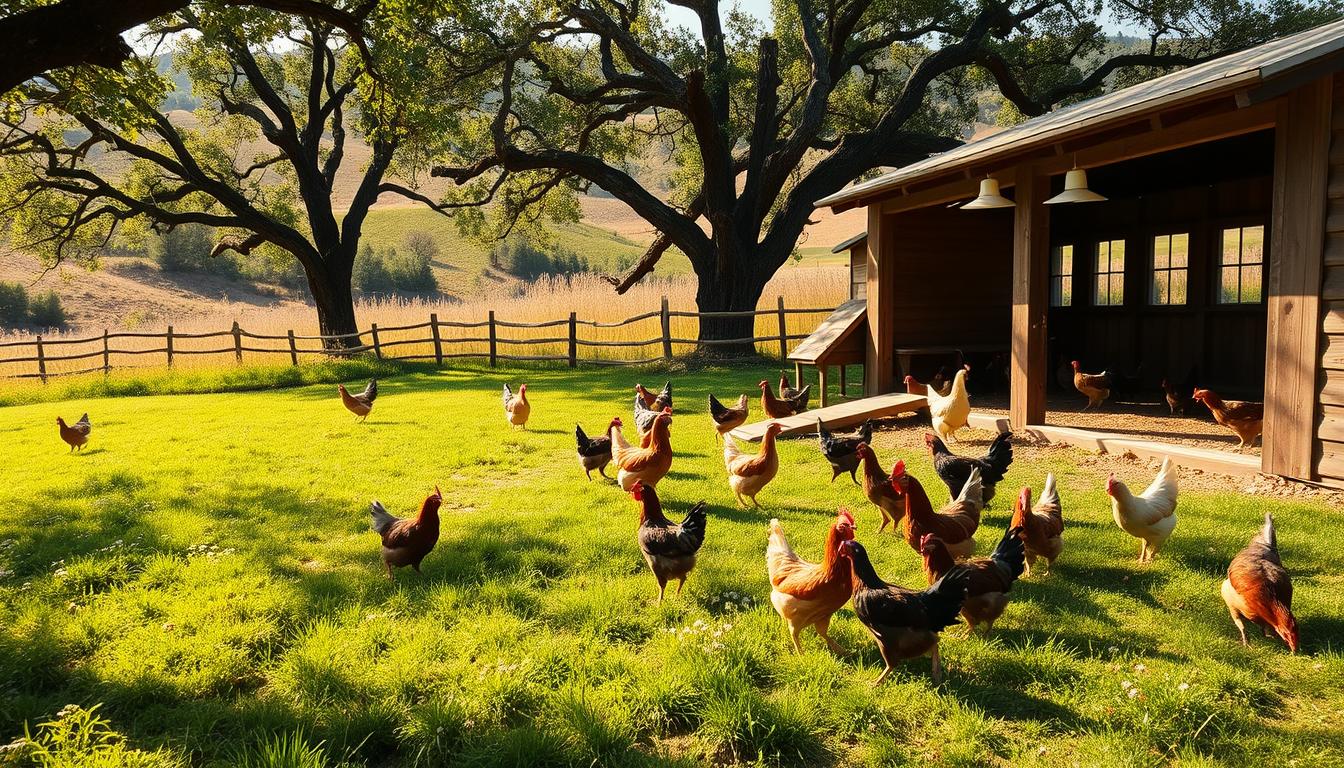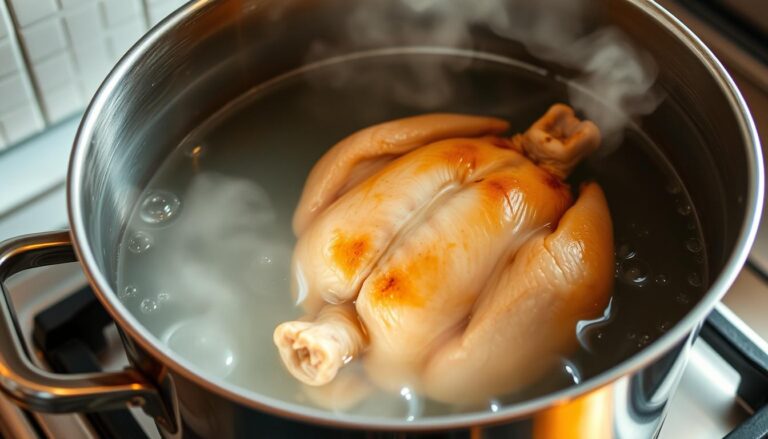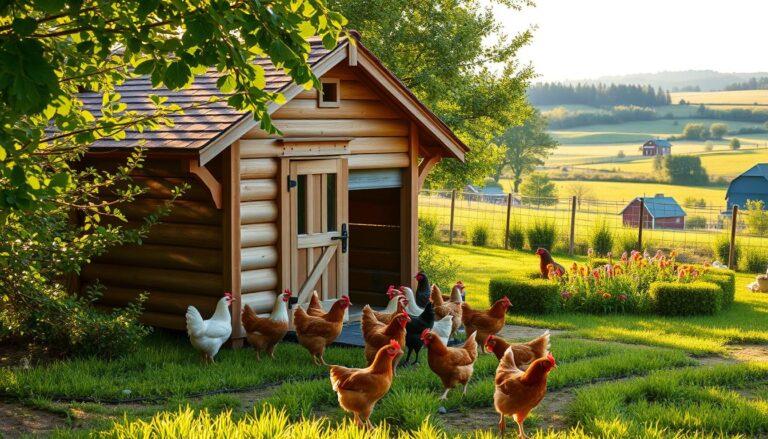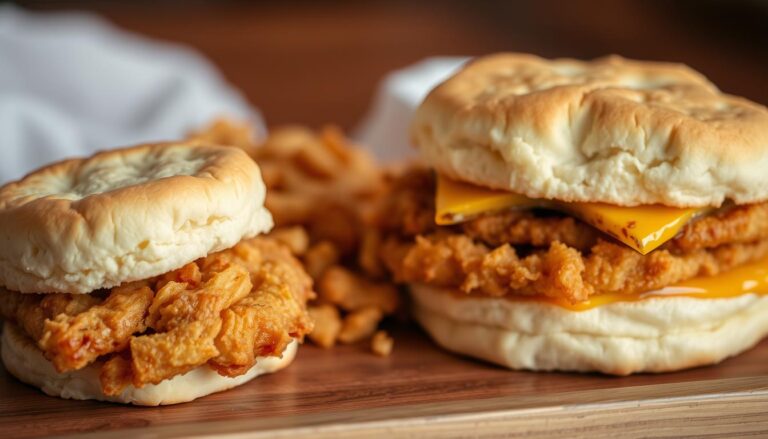What to Know About Chicken Pens and Setups
Table of Contents
What to Know About Chicken Pens and Setups
Thinking about adding chickens to your backyard? It’s important to keep them safe and happy. The right backyard chicken enclosures are key for their health and productivity. A good enclosure protects them from predators and makes their home comfortable.
Whether you’re new to chickens or have experience, knowing about chicken pens is essential. This guide will help you design, build, and maintain the perfect enclosure for your backyard.
Click here if you are interesed :Perfect for Backyard Poultry, Easy Installation &,Farm Roost Toys for Chickens (55′ L x 40′ W)

Key Takeaways
- Understand the importance of secure enclosures for your flock’s safety.
- Learn about the different types of backyard chicken enclosures.
- Discover essential features to include in your chicken pen design.
- Find out how to maintain a healthy and happy environment for your chickens.
- Explore tips for avoiding common pitfalls in chicken pen setup.
Understanding the Importance of Chicken Pens
A well-built chicken pen is key to successful backyard poultry keeping. It keeps your chickens safe and healthy. Good poultry housing does more than just provide shelter. It creates a safe space that helps your chickens stay healthy and makes caring for them easier.
Chicken pens offer many benefits. They protect your chickens from predators and diseases. They also make it simpler to manage your flock’s health and egg production. Plus, they stop chickens from damaging your garden or nearby properties.
Benefits of Keeping Chickens in Pens
Keeping chickens in pens makes them safer. Predators like foxes and hawks find it harder to get to them. Pens also keep your chickens clean and reduce disease risks.
| Benefit | Description |
|---|---|
| Predator Protection | Secure pens prevent predators from accessing your chickens. |
| Disease Control | Containment reduces the risk of disease transmission. |
| Egg Collection | Easier collection of eggs from designated nesting boxes. |
Risks of Free-Ranging Chickens
Free-ranging chickens get exercise and varied diets. But, they face dangers like predators and property damage. They might also eat harmful plants.
It’s important to think about these risks and benefits when managing your flock.
Choosing the Right Location for Your Pen
Choosing the right spot for your chicken pen is important. Consider sun, drainage, easy access, and closeness to your home. A good location makes your chickens happy and care easier for you.
By thinking about these points and the importance of good chicken pens, you can set up a great system for raising chickens. This system benefits both you and your chickens.
Types of Chicken Pens Available
There are many types of chicken pens for backyard chicken keepers. The right pen can impact your flock’s health, safety, and productivity.
Portable Chicken Pens
Portable chicken pens, or chicken tractors, are flexible. They let your birds get fresh ground often. These pens move around the yard, giving your chickens fresh forage.
When picking a portable pen, look for designs that are easy to move but also protect from predators.
Portable chicken pens offer:
- Flexibility in managing grazing areas
- Reduced risk of soil depletion
- Improved chicken health through fresh forage
Permanent Chicken Coops
Permanent chicken coops are stable and secure. They can be simple sheds or elaborate designs with runs. When choosing a permanent coop, think about its strength, ventilation, and cleaning ease.
Permanent chicken coops have:
- Enhanced security against predators
- Better climate control for your chickens
- Ease of management and maintenance
Custom-Built Options
Custom-built chicken pens are great for unique needs or small spaces. A custom pen can solve yard shape issues, specific predator problems, or breed-specific needs.
Custom-built chicken pens offer:
- Tailored solutions for your yard and needs
- Potential for innovative features or designs
- Optimized space use
Key Features of Effective Chicken Pens
To keep your chickens healthy and happy, focus on the pen’s key features. An effective chicken pen is more than a shelter. It’s vital for your flock’s well-being.
When designing or choosing a chicken pen, consider several critical elements. These elements ensure your chickens’ health, safety, and productivity. Together, they create a comfortable and secure space.
Sizing Your Chicken Pen
The pen’s size is key to your chickens’ health and happiness. Aim for 2-4 square feet per chicken inside the coop and 8-10 square feet per chicken in the outdoor run. But, more space is always better.
Too little space can cause stress, disease, and behavioral issues. So, plan your pen size based on your flock’s size. Larger breeds or more active chickens might need even more space.
Ventilation and Airflow Considerations
Good ventilation is essential for removing harmful substances from the pen. Proper airflow helps regulate temperature and prevents harmful gas buildup.
You can choose from simple to complex ventilation systems. The right choice depends on your climate, pen size, and budget.
- Ensure there are windows or vents that can be opened and closed as needed.
- Consider adding a ridge vent along the top of the coop roof for continuous airflow.
- Use fans during hot weather to improve air circulation.
Weatherproofing Your Structure
Weatherproofing keeps your chickens safe from rain, snow, wind, and heat. Use the right materials and design to keep the pen dry, draft-free, and insulated.
Techniques include waterproof roofing, insulation, and ensuring good drainage. Regular maintenance is also key to prevent weather damage.
By focusing on these features, you can create a pen that meets your chickens’ needs and improves their life quality.
Necessary Supplies for Chicken Pens
A well-stocked chicken pen is key to a successful backyard flock. It needs careful thought about necessary supplies. To keep your chickens healthy, happy, and productive, you must have the right materials and accessories.
Fencing Materials
The fencing around your chicken pen is vital. It keeps predators out and stops chickens from escaping. When picking fencing, think about durability, how well it works, and the cost.
- Hardware cloth is a top pick because it’s strong and keeps predators away.
- Chicken wire is less secure but good for extra enclosure or covering runs.
- Electric netting is flexible and portable, great for moving the pen around.
Nesting Boxes and Perches
Nesting boxes and perches are essential for your chickens’ comfort and health.
- Nesting boxes should be quiet and safe for hens to lay eggs. You’ll need one for every 3-4 hens.
- Perches let chickens roost comfortably. Make sure they’re strong and not too crowded.
It’s important to have the right size and place them well in the coop.
Feeding and Watering Systems
Good feeding and watering systems are vital for your chickens’ health and less waste.
- Feeders should cut down on spills and keep food clean.
- Waterers must be easy to clean, accessible, and won’t freeze.
You can choose from simple DIY setups to automated systems. Pick what fits your flock size and how you manage them.
Planning Your Chicken Pen Setup
Creating a well-planned chicken pen setup is essential for a stress-free chicken-keeping experience. Good planning makes sure your pen is both functional and safe. It also meets the needs of your chickens.
Assessing Space and Layout
Before you start building your chicken pen, it’s important to check the space in your backyard. Think about the area’s size and the best layout for you and your chickens.
- Measure the area’s length and width to find out the pen’s maximum size.
- Consider the area’s shape and how it can fit a pen and run.
- Think about the pen’s location near your house and other backyard features.
Incorporating Run Area for Chickens
A chicken run lets your chickens exercise, get fresh air, and enjoy sunlight. When adding a run to your pen, keep these points in mind:
- The run’s size should match your flock’s size.
- Choose durable, predator-proof fencing material.
- Add shade structures or dust baths to make their experience better.
Creating a Safe Entry and Exit
Safe entry and exit points are key for both chickens and keepers. Here’s what to consider when designing these areas:
- Use secure doors and gates that keep predators out.
- Make sure entry and exit points are easy to use for egg collection and pen upkeep.
- Think about adding a locking mechanism to keep the pen secure.
By planning your chicken pen setup carefully, you can create a backyard chicken enclosure that’s both functional and safe for your flock.
Chicken Pen Maintenance Essentials
A well-maintained chicken pen is key to a happy backyard flock. Regular care keeps your chickens healthy and your pen in good shape.
Several important tasks make up regular maintenance. Cleaning your chicken pen regularly is essential to stop disease and cut down on smells. How often you clean depends on your pen’s size, how many chickens you have, and what bedding you use.
Cleaning Your Chicken Pen Regularly
Creating a cleaning schedule is important. Daily tasks might include removing dirty bedding and waste. Weekly, you could disinfect feeding and watering spots. Every month, do a deep clean, replacing bedding and disinfecting everything.
Maintaining Fencing and Roof
The fencing and roof protect your chickens from predators. It’s important to check them often for damage. Look for signs of wear and tear, like rust or rot, and fix them quickly.
Checking for Pests and Predators
Pests and predators are dangers to your flock. Check your pen for mites, rodents, and other pests. Watch for droppings, gnaw marks, or disturbed bedding. Use pest-resistant materials and seal holes to keep them out.
By following these maintenance steps, you can keep your chickens safe, healthy, and happy.
Factors to Consider When Building a Chicken Pen
Before you start building your DIY chicken pens, it’s essential to consider several critical factors. Building a chicken pen is not just about constructing a simple enclosure. It involves creating a safe, healthy, and productive environment for your chickens.
One of the first considerations is local regulations and zoning laws. These can vary significantly from one municipality to another. Non-compliance can result in fines or even forced removal of your chicken pen. You need to research the applicable rules regarding flock size, rooster restrictions, setbacks from property lines, and permit requirements.
Local Regulations and Zoning Laws
Understanding local regulations is key. You should check with your local government to determine the specific regulations in your area. Some areas may have specific requirements for the size and location of chicken pens, as well as the number of chickens you can keep.
For instance, some municipalities may require a permit to keep chickens. Others may have specific rules about noise levels or the proximity of chicken pens to neighboring properties.
Choosing Appropriate Materials
Choosing the right materials for your chicken pen is vital for its durability and the health of your chickens. The materials you choose will impact the longevity of your structure and the well-being of your flock.
When selecting materials, consider factors such as durability, toxicity, and suitability for your climate. For example, you may want to use materials that are resistant to rot and insect damage if you live in a humid climate.
- Consider using recycled materials or sustainably sourced wood for your chicken pen.
- Metal wire mesh can be an effective material for fencing, but ensure it’s coated to prevent rust.
- Plastic or metal roofing materials can provide durability and weather resistance.
Cost Considerations
Cost is another critical factor to consider when building a chicken pen. The cost can vary widely depending on the size of your pen, the materials you choose, and whether you decide to build it yourself or hire a contractor.
To budget realistically, consider the typical expenses associated with different pen styles and sizes. You should also think about ways to save money without compromising on quality.
| Material | Cost | Durability |
|---|---|---|
| Wood | Moderate | High |
| Metal | High | Very High |
| Plastic | Low | Moderate |
By carefully considering these factors, you can create a chicken pen that is not only compliant with local regulations. It will also provide a healthy and safe environment for your chickens, while being mindful of your budget.
Popular Chicken Breeds and Their Needs
Different chicken breeds have unique needs that affect your chicken pen’s design. It’s important to know these needs to create a happy and healthy flock.
Understanding Breed-Specific Requirements
Each breed handles temperature, foraging, and flying differently. For example, Leghorns are more active and need more space than calm breeds like Orpingtons. Knowing these needs helps you design a pen that fits your flock’s needs.
Space Needs for Different Breeds
Chickens need different amounts of space based on their breed. Bantams need less space than bigger birds. Active breeds need big run areas, while calm ones do well in smaller spaces. Having enough space is key to keeping your chickens happy and healthy.
Social Behaviors in Chickens
Chickens are social and have complex behaviors. It’s important to design a pen that reduces stress and fights. Features like multiple feeding stations, visual barriers, and enough perch space help create a peaceful flock.
Seasonal Considerations for Chicken Pens
As the seasons change, your chicken pen needs to adjust. This ensures your flock stays healthy and comfortable. Different weather conditions, like cold, heat, and rain, bring their own challenges. By preparing your chicken pen for these changes, you can keep your chickens safe and healthy all year.
Preparing for Winter Conditions
Winter brings cold, snow, and ice, making it tough for chickens. To keep them warm and healthy, consider these steps:
- Ensure good insulation in the coop to retain warmth.
- Use windbreaks or snow fencing to protect the coop from harsh winds.
- Provide a safe and dry area for your chickens to roost.
- Consider using a heating system, but ensure it’s safe and well-ventilated.
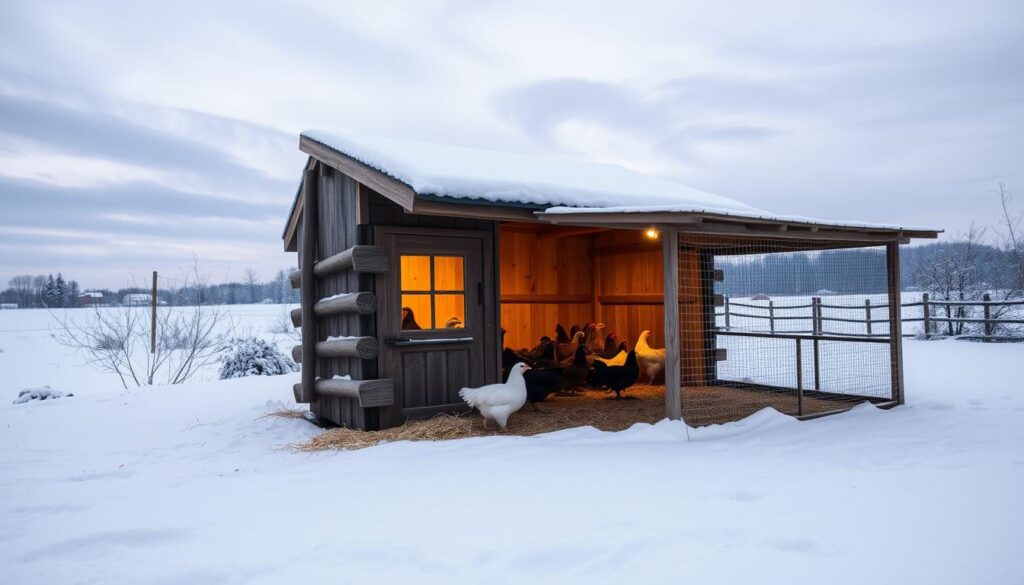
Managing Heat in Summer Months
Summer heat can be as tough as winter cold. To keep your chickens cool, focus on:
- Providing shade for your chickens to escape the direct sun.
- Enhancing ventilation in the coop to improve airflow.
- Using cooling methods such as misting systems or fans.
- Ensuring access to plenty of cool, fresh water.
Adapting to Rainy Weather
Rainy weather can make the run area muddy and uncomfortable for chickens. To manage this, consider:
- Improving drainage around the coop and run.
- Using roof extensions or canopies to keep the run dry.
- Considering the use of gravel or sand in the run to reduce mud.
- Regularly cleaning the coop to prevent the buildup of moisture and bacteria.
Common Mistakes in Chicken Pen Setup
Setting up a chicken pen can be tough, but knowing common mistakes helps a lot. When you’re making your DIY chicken pen, think about a few important things. These will help keep your chickens healthy and happy.
Overcrowding Your Chicken Pen
One big mistake is putting too many chickens in the pen. Not enough space can make chickens sick, cause fights, and lower egg production. You should give each chicken 2-4 square feet inside the pen and more in the run area.
Too many chickens can stress them out, leading to fights. To prevent this, plan your chicken pen setup well. Think about how big your chickens will be and what they need based on their breed.
Ignoring Predator Precautions
Not protecting your chickens from predators is another big mistake. Poles and other predators can easily get into pens that aren’t well-protected. To keep your chickens safe, you need to protect against digging and climbing predators.
Use strong fencing, bury it underground to stop digging, and cover the top to keep out birds. These steps can greatly lower the chance of predators getting to your chickens.
Neglecting Ventilation Needs
Not having enough ventilation in your chicken pen can make your chickens sick. Bad air can cause breathing problems and make the pen too wet. This is bad for both your chickens and you.
To fix this, make sure your pen has good airflow. Use windows, vents, or mesh to let air in but keep out the weather. Also, clean and maintain the pen regularly to avoid health problems.
Tips for Enhancing Chicken Welfare
To keep your chickens happy and thriving, it’s essential to consider their welfare when designing their pen. Enhancing chicken welfare goes beyond meeting their basic needs. It involves creating an environment that promotes natural behaviors and optimal health.
Enrichment Ideas for Your Chickens
Enrichment is key to preventing boredom and behavioral problems in chickens. You can achieve this by incorporating various elements into their pen.
- Perches at Various Heights: Installing perches at different heights encourages chickens to roost and exercise.
- Dust Bathing Areas: Creating areas for dust bathing helps chickens maintain their plumage and reduce parasites.
- Foraging Opportunities: Providing foraging opportunities, such as scattering treats or using foraging toys, stimulates natural foraging behavior.
- Simple Chicken “Toys”: Hanging objects like cabbages or using puzzle feeders can keep chickens engaged.
Socialization Strategies
Socialization is key to maintaining harmony within the flock. Strategies include integrating new birds gradually and using pen design features to facilitate smoother flock dynamics.
- Visual Barriers: Using visual barriers can help reduce stress by blocking the view between new and existing birds.
- Temporary Separation Areas: Having temporary separation areas allows you to isolate new birds before introducing them fully to the flock.
Monitoring Health and Behavior
Regular health monitoring is easier with a well-designed pen. Features such as good lighting, convenient access points, and observation areas make it simpler to spot early signs of illness or injury.
- Good Lighting: Ensure the pen is well-lit to observe the chickens’ condition clearly.
- Convenient Access: Design the pen with easy access points for regular inspections.
- Observation Areas: Create areas from which you can observe the chickens without disturbing them.
| Enrichment Activity | Benefits |
|---|---|
| Perches at Various Heights | Encourages roosting and exercise |
| Dust Bathing Areas | Maintains plumage and reduces parasites |
| Foraging Opportunities | Stimulates natural foraging behavior |
By following these tips and incorporating welfare-enhancing elements, you can create a more nurturing environment for your chickens. This leads to a happier, healthier flock.
Sustainable Practices in Chicken Rearing
Using sustainable practices in chicken rearing helps the environment and your chickens. When planning your backyard chicken enclosures and chicken run ideas, think about eco-friendly methods. This can make chicken-keeping more productive and healthier for your flock.
Composting Waste from Chicken Pens
Composting turns waste into something useful. Design your chicken pen to collect waste easily. This way, you can make compost that’s great for your garden.

Sourcing More Natural Feed
Using natural feed supplements can lessen your need for commercial feed. Add areas for chickens to find fresh greens. You can do this with rotational grazing or by planting chicken-friendly plants around your chicken run ideas.
“The way we feed our chickens can have a significant impact on their health and the environment. Sourcing local and organic feed can reduce carbon footprint and improve the quality of eggs.” – Sustainable Farming Expert
Creating a Cooperative with Neighbors
Starting a cooperative with neighbors can share resources and knowledge. This makes chicken rearing more fun and efficient. Together, you can buy better waste management and feed systems, and work on keeping predators away.
- Share knowledge and resources with neighbors.
- Invest in cooperative waste management systems.
- Collaborate on predator prevention.
Adopting sustainable practices like composting, natural feeding, and community cooperation makes chicken-keeping better. These actions help your flock and the environment.
Resources for Chicken Pen Enthuisiasts
As you work on your chicken pen, it’s good to use many resources. They offer expert advice and help. You can find detailed plans for hen houses and cool coop accessories.
Reliable Guides and Literature
Books and guides give deep info on chicken housing. They cover topics like keeping predators out, using automated systems, and designs for different climates. These resources help you make your chicken pen better.
Online Forums and Communities
Online communities and forums connect you with chicken keepers who know a lot. They share ideas, help with problems, and give feedback on your plans. You can learn about different coop accessories and hen house plans from their experiences.
Practical Workshops and Classes
Local workshops and classes teach you how to build and manage chicken pens. You can learn from experts in your area. Look for extension services, agricultural programs, and homesteading groups that offer classes and support.
FAQ
What size should my chicken pen be?
How often should I clean my chicken pen?
What materials are best for chicken pen fencing?
How can I protect my chickens from predators?
What are the essential features of a well-designed chicken pen?
Can I build a chicken pen myself, or should I buy one?
How do I ensure proper ventilation in my chicken pen?
What are some common mistakes to avoid when building a chicken pen?
How can I make my chicken pen more sustainable?
What factors should I consider when choosing a location for my chicken pen?
For more cooking tips, stay connected with us. We also recommend the cookbook Skinnytaste Simple: Easy, Healthy Recipes with 7 Ingredients or Fewer
For more Recipes about Chicken

